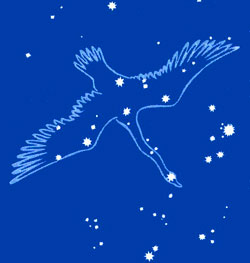|
from ChateauLalinde Website
Why exactly the cult of the swan might have existed in megalithic Ireland, and indeed among several other key Neolithic stone monuments in the British Isles, is not clear.
Avebury, Wayland Smithy long barrow and Callanish are all aligned
Moreover, such beliefs in Europe go back at least to 4800 BC, since a Mesolithic burial unearthed recently in Denmark was found to contain a woman and her young child, who had been laid to rest on a giant swan's wing.
Indeed, it moved prehistorian and Palaeolithic expert Steven Mithen to comment:
The cult of Cygnus is integrally related to the shamanic process of entering the sky-world (heaven if you like) via a perceived sky-pole that terminates in something known to mythologists as the cosmic axis, synonymous with the north celestial pole.
This is marked in the night sky by the Pole Star, or North Star, currently Polaris in Ursa Minor, although this is simply the latest in a series of pole stars which feature during the Earth's 26,000-year precessional cycle.
As the perceived guardian of the entrance to the sky-world, Cygnus as the cosmic bird, positioned at the most northerly extent of the Milky Way, is at the heart of ancient cosmologies and religions worldwide.
It has been a major
influence on the design and orientation of sacred architecture,
which, in addition to the megalithic monuments of Britain and
Ireland, includes
This belief is found within the religions of various Middle Eastern sects descended from the star-worshipping Sabians of Harran (known as the Chaldeans in the Bible).
They include the angel-worshipping
Yezidi of Syria and Upper Iraq, the Mandaeans of Iraq and Iran, and
the Shi'i Muslim sect called the Brethren of Purity.
|

 towards either the rising or setting of key stars in
the celestial
swan, which since Palaeolithic times has been seen as a primary
symbol of the cult of dead and rebirth across Europe and Asia.
towards either the rising or setting of key stars in
the celestial
swan, which since Palaeolithic times has been seen as a primary
symbol of the cult of dead and rebirth across Europe and Asia.

